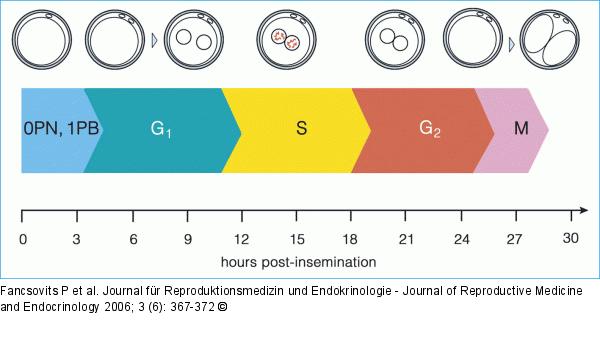Fancsovits P, Takacs FZ, Tothne GZ, Papp Z, Urbancsek J Examination of Early Cleavage an its Importance in IVF Treatment Journal für Reproduktionsmedizin und Endokrinologie - Journal of Reproductive Medicine and Endocrinology 2006; 3 (6): 367-372 Volltext (PDF) Summary Übersicht
| ||||
Abbildung 1: First Cell Cycle Timing of the first cell cycle of a human zygote. The upper figure line indicates the biological occurrence in oocytes from fertilization to first cleavage. Following sperm penetration, the second meiotic division is completed. After first polar body extrusion, the G1-phase of the first cell cycle begins, in which male and female pronuclei appear. The G1-phase is followed by the S-phase in which the chromosomes replicate. It is followed by the G2-phase in which DNA synthesis cannot be observed any more. The M-phase of the first cell cycle begins with the disappearance of pronuclei and lasts until completion of the first cell division. 0PN = no pronucleus; 1PB = one polar body; G1, S, G2, M: phases of cell cycle [Author permission granted by P. Fancsovits] |

Abbildung 1: First Cell Cycle
Timing of the first cell cycle of a human zygote. The upper figure line indicates the biological occurrence in oocytes from fertilization to first cleavage. Following sperm penetration, the second meiotic division is completed. After first polar body extrusion, the G1-phase of the first cell cycle begins, in which male and female pronuclei appear. The G1-phase is followed by the S-phase in which the chromosomes replicate. It is followed by the G2-phase in which DNA synthesis cannot be observed any more. The M-phase of the first cell cycle begins with the disappearance of pronuclei and lasts until completion of the first cell division. 0PN = no pronucleus; 1PB = one polar body; G1, S, G2, M: phases of cell cycle [Author permission granted by P. Fancsovits] |


